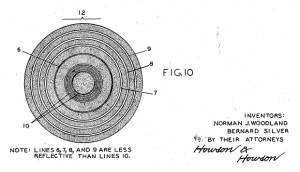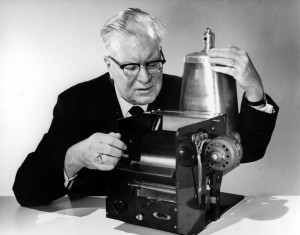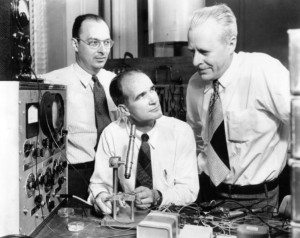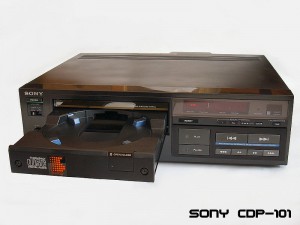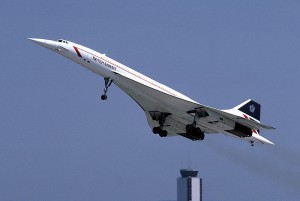Miscellaneous Technology
Barcode Technology Patented
American inventors Norman Joseph Woodland and Bernard Silver are granted US Patent #2,612,994 for “Classifying Apparatus and Method,” described as “article classification through the medium of identifying patterns.” Of course, today we better know these “identifying patterns” as barcodes. Woodland and Silver eventually sold their patent for only $15,000 but were later inducted into the Inventors Hall of Fame.
Barcodes were first used commercially in 1966 and it rapidly developed that eventually by 1970, there was a requirement to have some sort of industry standard set. A company called Logicon Inc. created the Universal Grocery Products Identification Code or UGPIC for short in order to implement the barcode throughout the retail industry.
Monarch Marking, based in the United States of America, was the first company to produce barcode equipment using UGPIC for retail trade use. British company, Plessey Telecommunications followed suit, creating their equipment later in the same year.
The UGPIC was transformed into UPC, or Universal Product Code symbol set, which is still used in the United States of America. The first piece of equipment using UPC was installed in a Marsh’s supermarket in Ohio and the first product checked out using a barcode was a packet of Wrigley’s Juicy Fruit Chewing Gum on June 26, 1974.
Special thanks to Jonny Rowntree of Elanders UK for sending me the background information for this article!
Photocopying Patented
Chester Carlson is issued a patent on a process called electrophotography, now commonly known as photocopying. It was not until 1946 that a company had any interest in pursuing photocopying commercially. The Haloid Company finally licensed Carlson’s patent and created the word xerography to differentiate the process from traditional photography. Eventually, photocopying became such a large part of the company’s revenue that Haloid changed their name to Xerox.
Transistor Patented
AT&T Bell Laboratories researchers John Bardeen, Walter Brattain, and William Shockley receive a US Patent for their invention of the transistor, which they had successfully demonstrated two years earlier. The transistor completely revolutionized the development of electronic and computerized technology.
The First CD Player
Concorde Breaks Atlantic Crossing Speed Record
The supersonic aircraft Concorde makes its first non-stop Atlantic crossing and sets a new speed record in the process. Flying from Washington D.C. to Paris, France in 3 hours 32 minutes at an average speed of 954 miles-per-hour, the Concorde cut the old speed record in half.
First Test of an Integrated Circuit
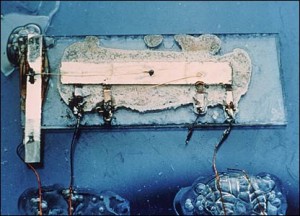 September 12, 1958
September 12, 1958
Researcher Jack Kilby demonstrates the first integrated circuit to other researchers and executives at Texas Instruments.
RIAA Sues A Twelve-Year Old
 September 8, 2003
September 8, 2003
The Recording Industry Association of America (RIAA) sues 261 people for sharing music on Internet peer-to-peer networks, including 12-year old Brianna LaHara. Eventually bringing suit against at least 30,000 people, the RIAA intended to reduce the amount of music being shared, but instead generated a public backlash against the established recording industry.
iPod Nano Introduced
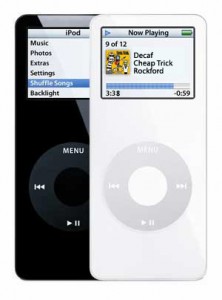 September 7, 2005
September 7, 2005
Apple introduces the iPod Nano, effectively replacing the iPod Mini. The move surprised many in the industry, as the iPod Mini was extremely popular. However, the use of flash storage instead of a hard drive allowed for a much smaller form factor, increased reliability, and better battery life. These improvements proved extremely popular with consumers as one million units were sold in the first 17 days. The pioneering use of flash storage in a consumer electronic device paved the way for its use in many future Apple product designs, such as the iPhone, iPad, and flash storage-based MacBooks.
Faraday Discovers Electromagnetic Induction
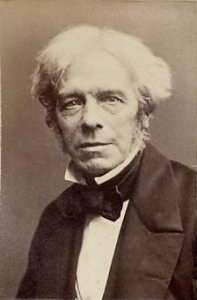
English scientist Michael Faraday discovers electromagnetic induction. Electromagnetic induction is the primary principle behind electric motors and electric generators, two very important inventions that power and drive our electronic technology of today.
World’s Largest Battery Backup

The city of Fairbanks, Alaska connected to what was at the time the world’s largest battery backup. Designed to help prevent serious blackouts that plagued the city every two to three years, the batteries could provide power to the city for a few minutes – enough time to start up the city’s backup diesel generators. The battery contains 13,760 cells covering more than 10,000 square feet. It was reported that in the first two years of operation, the battery system prevented at least 81 power failures.

